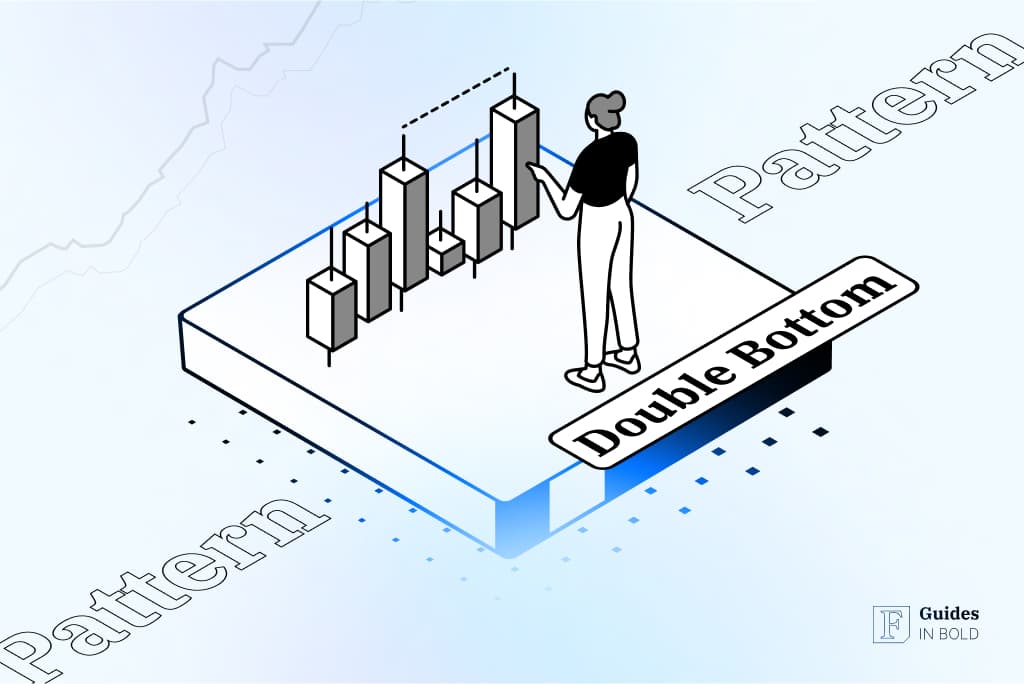A double bottom pattern is one of the more commonly used chart patterns in technical analysis. If you’re interested in finding profitable opportunities with a double bottom pattern, this guide will first explain what a double bottom pattern is, how to identify one, and finally, how to trade a double bottom chart formation.
Best Crypto Exchange for Intermediate Traders and Investors
-
Invest in cryptocurrencies and 3,000+ other assets including stocks and precious metals.
-
0% commission on stocks - buy in bulk or just a fraction from as little as $10. Other fees apply. For more information, visit etoro.com/trading/fees.
-
Copy top-performing traders in real time, automatically.
-
eToro USA is registered with FINRA for securities trading.
What is a double bottom pattern?
Marking the beginning of a potential future uptrend, a double bottom pattern is a bearish-to–bullish price reversal that signals a continuous downtrend has bottomed out. It shows that the price is about to rise again, which describes a change in a previous trend and a momentum reversal from the most recent leading price. A double bottom pattern is the opposite of a double top, which suggests a bullish-to-bearish trend reversal.
A double bottom pattern forms when the price of an asset, for example, of a stock or a cryptocurrency, suddenly decreases further after a long consistent downtrend, rebounds, and drops again for the second time to the same or similar price level as the first drop. After which, the price rebounds and breaks through, forming a bullish price reversal after a bearish trend.
What does a double bottom pattern look like?
A double bottom chart pattern generally looks like the letter W, marking two price lows (bottoms) and three reversal points, and consists of three key elements.
A double bottom pattern consists of three parts:
- First low – first price reversal.
After a strong downtrend, the market bounces higher. Then, it forms a swing low – when the price is lower than any other prices over a given time, for example, the lowest price in the recent week. At this moment, it’s likely just a retracement in a downtrend, not an indication of a price trend reversal.
- Second low – second price reversal.
The second drop is formed as the market discounts the previous downtrend, and the buying pressure increases. As the second bottom forms, there are signs of a price reversal and uptrend. However, it is still too early to say if the prices will continue increasing.
- Neckline – an area of resistance.
The neckline or resistance level is the maximum price an asset can achieve over a period in an up-trending market. A double bottom pattern is complete if the price breaks above the neckline, indicating there are more buyers than sellers and that the trend is likely to continue moving higher.

Recommended video: Double Bottom & Double Tops Patterns Simply Explained
For beginner investors:
- What is Investing? Putting Money to Work
- 17 Common Investing Mistakes to Avoid
- 15 Top-Rated Investment Books of All Time
- How to Buy Stocks? Complete Beginner’s Guide
- 10 Best Stock Trading Books for Beginners
- 15 Highest-Rated Crypto Books for Beginners
- 6 Basic Rules of Investing
- Dividend Investing for Beginners
- Top 6 Real Estate Investing Books for Beginners
How to identify a double bottom pattern on a stock chart?
Now that we’ve clarified how a double bottom pattern looks on a stock chart let’s see how to identify one.
Steps to identify a double bottom pattern on a chart:
- Look for two noticeable lowest price points on a chart with a similar height and width;
- The distance between the two bottoms – the two lows – shouldn’t be too brief, but this depends on your chosen trading time frame;
- Draw the neckline/resistance level;
- To confirm a double bottom pattern, use other technical indicators like moving averages (MA) or oscillators;
- Make sure there’s enough trading volume in the second swing to confirm the trend strength – keep in mind not to trade against solid trends.
Types of stock chart patterns
A double bottom pattern is a chart or price pattern, or chart formation, that can be identified using various trend lines and curves, which makes chart patterns more apparent and recognizable. Chart formations can help investors identify potential trade entry prices and establish price targets and exit times.
There are two main types of chart patterns: a reversal pattern – when price changes and trend reversals occur, and a continuation pattern – if the trend continues in an existing direction.
A double bottom chart pattern is a price reversal pattern. Other common price patterns used in technical analysis are double top, triple bottom, triple top, or head and shoulders, which all point to an upcoming price trend reversal.
Stock chart reversal patterns:
- Head and shoulders (H&S);
- Inverse head and shoulders (H&S);
- Double top;
- Double bottom;
- Triple top;
- Triple bottom.
Stock chart continuation patterns:
- Triangles (symmetrical, ascending, and descending);
- Rectangles (bullish and bearish);
- Flags;
- Pennants.
How to trade a double bottom pattern?
There are two main ways to trade a double bottom pattern: first, place an order when the price breaks the neckline, or second, trade when the price retests the neckline, taking a long position. But before that, there are a few additional considerations that need to be paid attention to:
- The timelines – as with many other chart formations, it is best to look at medium to longer-term periods, as the trend’s strength and probability of it succeeding are higher. It’s good to use weekly or daily charts because although the formation might appear on intraday charts, it is less likely that the trend will succeed.
- Inspect that the duration between the two drops is long enough, as the chances of the chart pattern succeeding are higher and less likely to fail. An appropriate time for the pattern to complete should be at least three months.
- The trading volume – during the second bottom advance, it should be more significant than the first, showing the trend’s strength. A spike in the trading volumes indicates a higher demand and buying pressure, which confirms a successful double bottom chart pattern. It is common for the drop of the first advance to be around 10% – 20% and about 3% – 4% of the previous decrease.
In brief, there are two main ways to trade the double bottom pattern:
- Place an order when the price breaks the neckline;
- Place an order when the price retests the neckline.
1. Place an order when the price breaks the neckline
The first method to trade a double bottom pattern is to enter a trade when the price of an asset breaks the neckline/resistance of the chart formation.
The chart below is a visualization, an example of when to buy, place a stop-loss order, and profit targets.
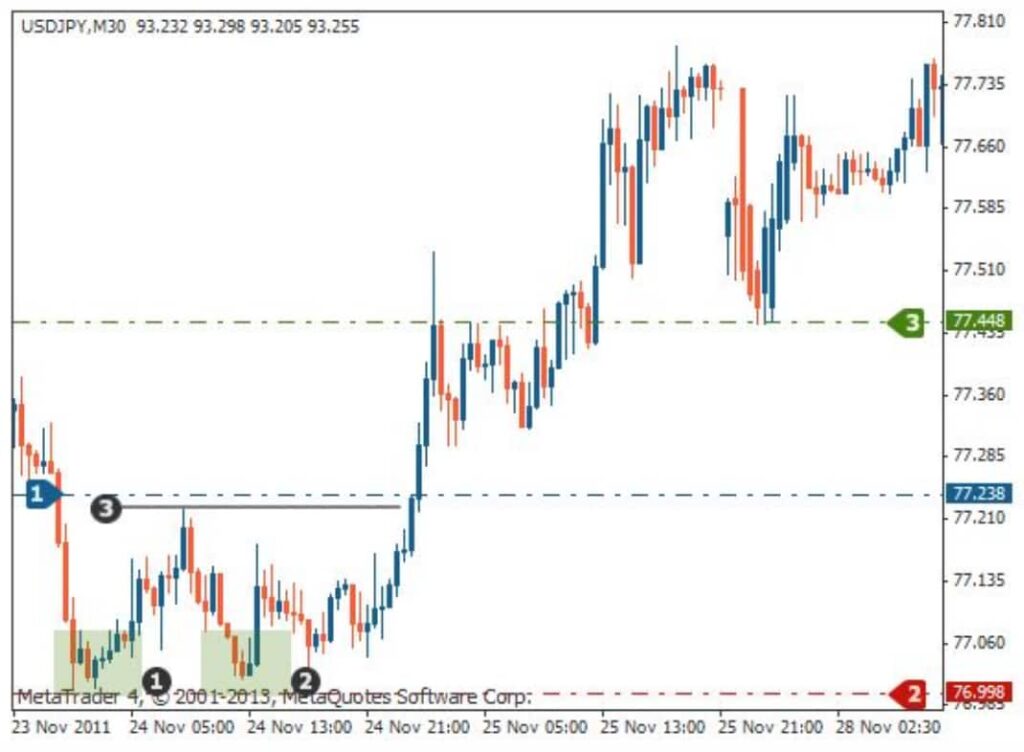
- Blue line – enter when the price of an asset breaks the neckline;
- Redline – place a stop loss order just below the formation;
- Green line – take the height of the double bottom pattern formation, and place a win target that much above the neckline.
So, to sum up, the first option to trade a double bottom formation is to enter the trade as soon as the pattern completes and the price breaks the neckline. Then, place the stop-loss order just below the lows and the profit target above the resistance line – the distance should equal the length between the lows and resistance (the pattern’s height).
2. Place an order when the price retests the neckline
The second way to trade a double bottom pattern is to wait a little longer before buying, see how the trend will play out, and place an order when the price retests the neckline.
First, wait for the price break above resistance. Then, as the price retests the new resistance level as support, a buy order is placed, and the stop loss is below the new support level. The profit target stays the same – the pattern’s height above the neckline.
The chart below shows how it looks on a chart and demonstrates the entry, stop-loss, and profit target levels.
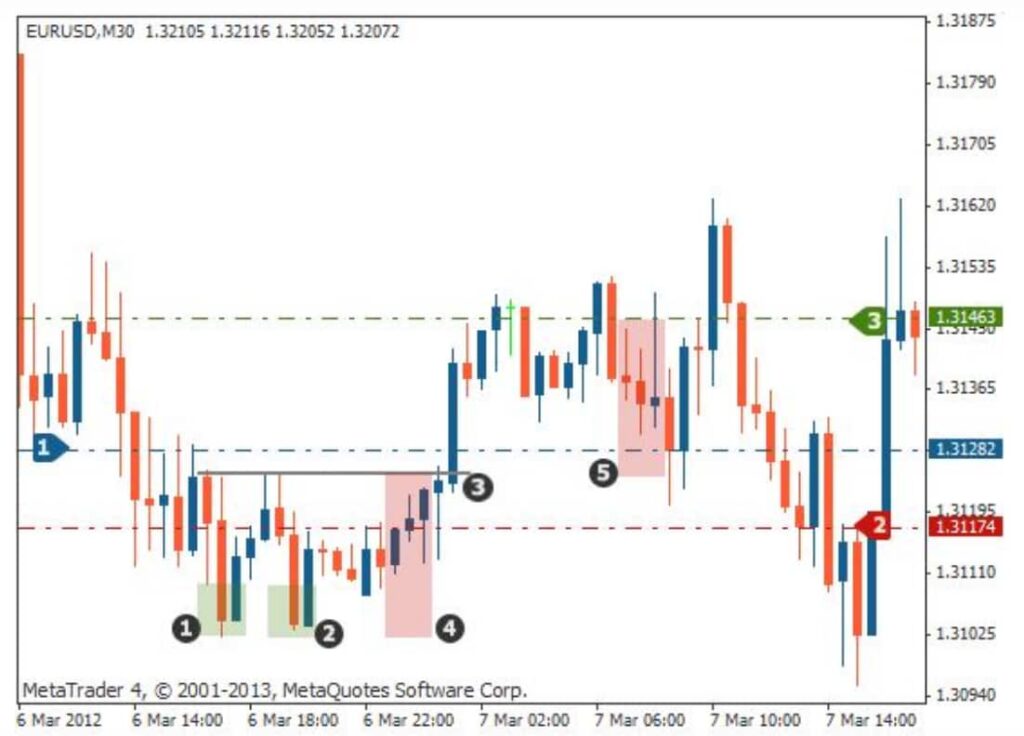
- Blue line – trade entry after the price retested the neckline as support (in the pink area);
- Redline – a stop loss order is placed below the new support;
- Green line – like the first version, a profit target is placed above the neckline. The distance is the full height of the double bottom formation.
To sum up, the first way is to place an order right when the price breaks the neckline, and the second is to wait until it retests the neckline and let the price break above the previous swing high.
It can be done in case you missed the first entry or to confirm the double bottom pattern is successful and shows strength from the buyers. However, the risk is missing the perfect entry point.
Double top vs. double bottom pattern
Both double bottom and double top patterns are price reversal patterns – a double top is the opposite of a double bottom pattern. For example, instead of forming two lows and three highs – which looks like the letter W, a double top pattern creates two consecutive highs and three lows – which looks like the letter M.
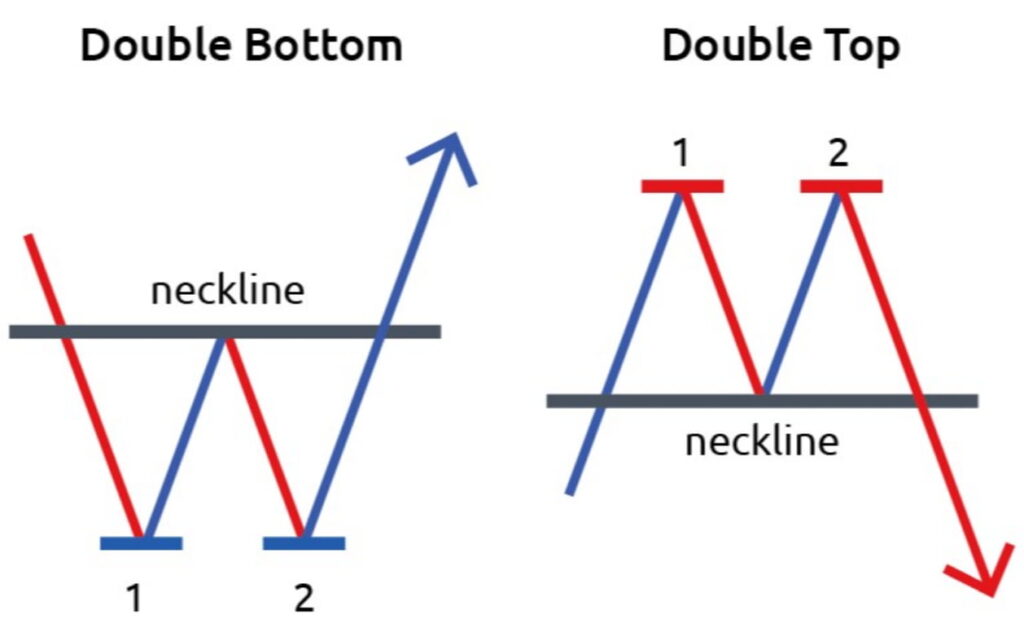
Whereas a double bottom pattern indicates a bearish-to-bullish trend reversal, a double top pattern shows a bullish-to-bearish change in the prevailing trend. A double top is a double bottom pattern in reverse and is set up according to similar principles.
When a double top pattern forms, the second top is usually slightly below the first peak, which indicates market exhaustion. When trading a double top pattern, traders would take a short position instead of a long position, as the prices are expected to start decreasing and showing signs of a downtrend.
Best Crypto Exchange for Intermediate Traders and Investors
-
Invest in cryptocurrencies and 3,000+ other assets including stocks and precious metals.
-
0% commission on stocks - buy in bulk or just a fraction from as little as $10. Other fees apply. For more information, visit etoro.com/trading/fees.
-
Copy top-performing traders in real time, automatically.
-
eToro USA is registered with FINRA for securities trading.
Failed double bottom pattern
Even though various chart patterns help execute profitable trades, it is only the case when these trends are identified correctly. A failed double bottom chart pattern is when the expected direction doesn’t materialize as expected.
In the below chart, we can see that the prices move in the opposite direction of what was first anticipated:
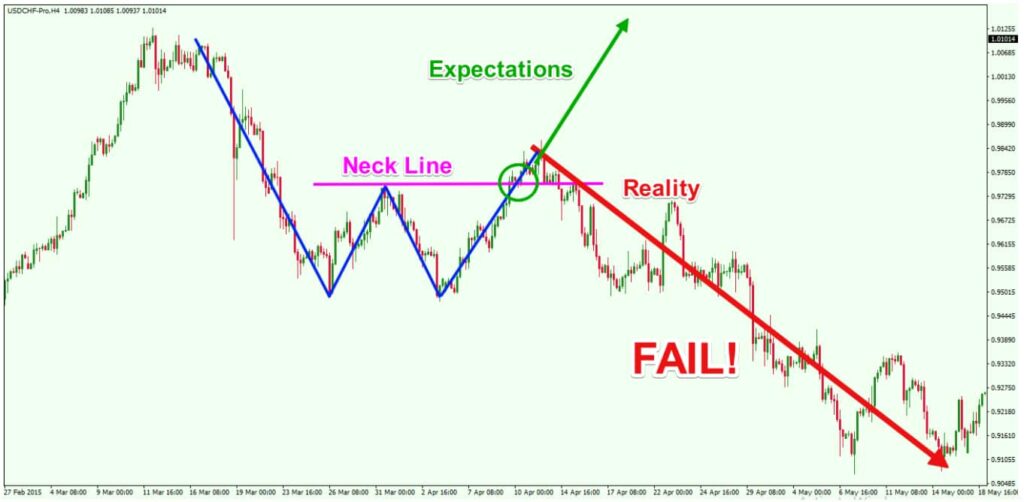
Although traders can incur losses, a failed double bottom pattern can also offer unique trading opportunities. For example, suppose a false breakout is identified at the right time – in that case, one can prepare to trade in the opposite direction, and go short instead.
Pros and cons of trading double bottom pattern

Pros
- Clear entry and exit points: One of the major advantages of the double bottom pattern is that it provides traders with relatively clear entry and exit points. Typically, traders might enter a long position after the second bottom forms and the price breaks the resistance level;
- Strong reversal indicator: A well-formed double bottom pattern is considered a strong bullish reversal indicator, suggesting a potential end to a prevailing downtrend;
- Widely recognized: Given its popularity and widespread use among traders, the double bottom pattern is easily recognized, allowing for collective trading behavior that often reinforces the pattern’s predictive power;
- Risk management: The pattern allows traders to set stop-loss orders just below the recent lows of the double bottom, providing a clear risk management strategy.

Cons
- False breakouts: Like all technical patterns, the double bottom can be subject to false breakouts where the price appears to confirm the pattern but then reverses back into the downtrend;
- Requires confirmation: To increase the odds of a successful trade, the pattern often requires additional confirmation, such as increased trading volume or other technical indicators, which might complicate trading decisions;
- Time-consuming: Waiting for the pattern to fully form before entering a trade can be time-consuming. Traders might miss out on other opportunities in the market while waiting for the double bottom confirmation;
- Not always 100% accurate: No technical pattern is foolproof. There’s always a risk that the market will not react as anticipated, leading to potential losses.
Conclusion
As with any other chart patterns used in technical analysis, a double bottom pattern is not guaranteed to succeed and is always up for individual interpretation. It takes practice to learn how to trade a double bottom pattern, as not every price pattern that forms will succeed.
To confirm a pattern and detect false signals, ensure all criteria are present, including a sharp bearish decline before the first bottom and increased trading volume at the second peak.
Disclaimer: The content on this site should not be considered investment advice. Investing is speculative. When investing, your capital is at risk.
FAQs
What is a double bottom pattern?
A double bottom pattern is a stock chart formation that indicates a bearish-to-bullish price trend reversal, used in technical analysis, commonly to trade stocks, forex markets, or cryptocurrencies. Meaning that the price of an asset that has been continuously decreasing over time is about to reverse and start increasing again.
Is double bottom pattern bullish or bearish?
A double bottom pattern is a bullish trend that hints prices have bottomed out, and a continued downtrend is about to reverse and turn bullish again, indicating an uptrend and an opportunity for investors to enter long trades.
How to identify a double bottom pattern?
To identify a double bottom pattern, look for a letter “W” shaped formation on a chart; it marks two price lows and three reversal points. Even though the formations don’t always appear as clearly, it is a good indication – look for two noticeable lowest price points over a specified time of a similar height and width, and then draw the support level. To confirm the trend, use technical indicators such as MA and oscillators to check enough trading volume.
How to trade a double bottom pattern?
There are two main ways to trade and confirm a double bottom pattern entry and exit prices. First, look where the price breaks the support level or neckline and place an order as soon as the pattern completes. Or, second, wait for the price to retest the neckline and enter the trade after the price retests the neckline as support.
How does the triple bottom pattern differ from the double bottom?
The triple bottom pattern is similar to the double bottom pattern, but instead of two troughs, it showcases three. In a triple bottom pattern, the asset’s price touches a support level three times before potentially rebounding upwards. This pattern is considered a stronger bullish reversal indicator than the double bottom because the asset has tested the support level multiple times, confirming its strength.
What's a double bottom pattern example?
Imagine a stock that has been in a downtrend for several months. The stock then reaches a low of $50, rises to $60, and then falls back to $50 again before beginning a significant upward trend. This price movement, where the stock hits the $50 mark twice before rising, is an example of a double bottom pattern. The two lows at the $50 level act as the “double bottom,” indicating a potential reversal from the prevailing downtrend.
